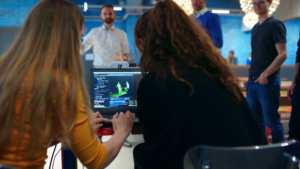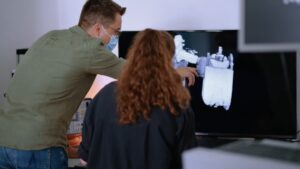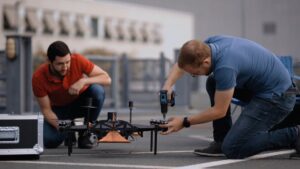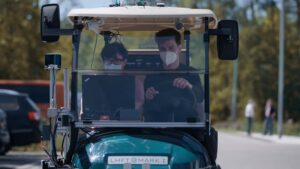YouTube
Shaping the Future with Microwave Technology
YouTube video series for insight of current research topics of the chair and the collaborative research centre EmpkinS.

Innovative Sensortechnologien für die berührungslose Diagnose und Überwachung der Gesundheit
In collaboration with clinics and universities across Germany, EmpkinS integrates different fields such as technology, medicine, psychology and ethics. The center focuses on groundbreaking areas such as machine learning, high-precision signal analysis and empatho-kinesthetic modeling. At its core is the contactless and therefore unbiased recording of the parameters of a broad spectrum of human movements, from the smallest muscle twitch to the largest jump. The most important research questions include recognizing emotions based on muscle twitches, understanding body movements as indicators of stress and depression, and using sleep patterns and movement analyses to improve the recording and monitoring of health status. EmpkinS aims to revolutionize patient care by exploring innovative, patient-centric technological solutions while addressing ethical and social issues to ultimately improve the quality of life for all.

Gotcha! Searching And Finding In The Internet Of Things
In this video, we present the “Next Big Thing” in the field of RFID technology. With the help of UHF RFID tags and readers, we are making everyday objects part of the Internet of Things. Our autonomous robot then ensures that nothing gets lost in libraries and other places. You will also find out what our RFID technology can be used for in the future. In this diverse subject area, we research and work, for example, in close and long-term cooperation with the company MetraLabs, our industrial partner and specialist for autonomous robots.

Imaging The Invisible
This video provides an insight into the broad research field of radar imaging. This technology is used, for example, in security applications at airports because it can generate images of layers that are not visible to the human eye. For many years, the LHFT was involved in the development of Rohde & Schwarz’s radar-based security scanners, which are now widely used at airports. At our institute, we want to take this technology in new directions and also use radar sensors in medical technology, for example, to record human movements with high precision for diagnostic and therapeutic purposes. This basic research is currently taking place within the framework of the DFG Collaborative Research Center 1483 “Empathokinesthetic Sensors” (in short: EmpkinS), in which we are collaborating with more than 50 scientists from FAU, TU Munich, TU Hamburg and the University Hospital Erlangen.

Anybody There? Searching For Extraterrestrial Life
This video shows how modern radar technology, which we are developing at our institute, can be used to look into ice layers. To do this, we conduct expeditions to high-altitude glaciers to use a drone to detect crevasses or water-bearing layers without contact. In this way, we hope not only to gain insights into the glaciers on our planet, but also to demonstrate the potential of the technology for future space missions to detect liquid water and thus perhaps even extraterrestrial life in our solar system.
We are researching and working in close cooperation with the German Aerospace Center (DLR) in this diverse topic area.

How Autonomous Vehicles See The World?
This video explores how autonomous vehicles see the world. With cameras, laser scanners, and special radars that we develop at the institute, objects and obstacles in the vehicle’s environment can be detected and interpreted. This understanding of the environment is one step on the way to fully autonomous driving. In this diverse subject area, we research and work in close and long-term cooperation with well-known automobile manufacturers and high-tech automobile suppliers.